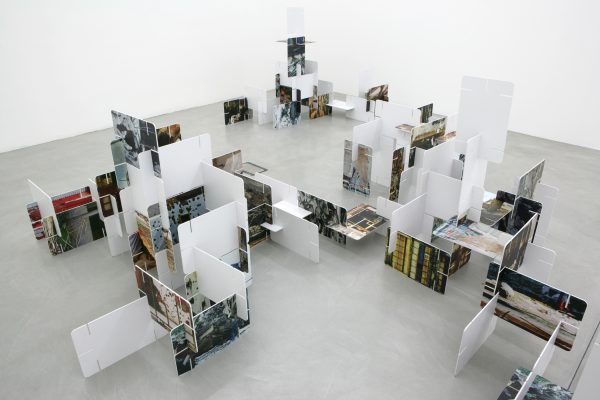Opening 27/03 - 27/03 - 12/05, 2007
-
Francesco Simeti
Derek Rowleiei
No place like home
For his second collaboration with the gallery, Francesco Simeti presents Rubble, an installation in which he revisits ‘House of Cards’, the famous work by the American designers, Charles and Ray Eames. Originally developed in 1952, their project reflected the almost utopian idea that industrial design could make the world a better, more pleasant place.
Simeti is interested in rethinking the structure of the game created by the Eames by altering its positive impact (their positive vision) through the use of harsh images of wartime rubble, debris and wreckage.
The artist does not reject a priori the two designers’ optimistic attitude, but he moves us to greater complexity of thought by inserting a disruptive element (the images) in order to underline the symbolic meaning of constructing and reconstructing in the midst of rubble.
Construction and deconstruction, the nature of the images utilized, and the playful structure of the installation are the dominant elements of the work. An aesthetic based on a dialectical contrast characterizes the present piece as well as Francesco Simeti’s previous work.
In a different way, the work Rowleiei House. Living room by Derek Rowleiei accompanies us with private, tiny works into the house suggested by Simeti’s installation, a house which is seen as a place of memory rather than a physical space.
The young Korean artist, with her first solo show at the gallery, evokes the domestic privacy of a living room through her graceful, miniaturistic signature style, suggesting faces, objects and atmospheres that are typical of private, familiar places.
Rowleiei’s work is a path among real and mythical characters, places and objects transformed, through recollection and imagination, into small icons of a world that is at once magical and mundane. The houses become tiny, the characters diminish in size until they become an ornamental element or turn into fanciful beings with zoomorphic features; in the artist’s poetic world everything changes dimension or morphology, disclosing the hidden, mysterious and unexpected side of what we consider familiar.
For his second collaboration with the gallery, Francesco Simeti presents Rubble, an installation in which he revisits ‘House of Cards’, the famous work by the American designers, Charles and Ray Eames. Originally developed in 1952, their project reflected the almost utopian idea that industrial design could make the world a better, more pleasant place.
Simeti is interested in rethinking the structure of the game created by the Eames by altering its positive impact (their positive vision) through the use of harsh images of wartime rubble, debris and wreckage.
The artist does not reject a priori the two designers’ optimistic attitude, but he moves us to greater complexity of thought by inserting a disruptive element (the images) in order to underline the symbolic meaning of constructing and reconstructing in the midst of rubble.
Construction and deconstruction, the nature of the images utilized, and the playful structure of the installation are the dominant elements of the work. An aesthetic based on a dialectical contrast characterizes the present piece as well as Francesco Simeti’s previous work.
In a different way, the work Rowleiei House. Living room by Derek Rowleiei accompanies us with private, tiny works into the house suggested by Simeti’s installation, a house which is seen as a place of memory rather than a physical space.
The young Korean artist, with her first solo show at the gallery, evokes the domestic privacy of a living room through her graceful, miniaturistic signature style, suggesting faces, objects and atmospheres that are typical of private, familiar places.
Rowleiei’s work is a path among real and mythical characters, places and objects transformed, through recollection and imagination, into small icons of a world that is at once magical and mundane. The houses become tiny, the characters diminish in size until they become an ornamental element or turn into fanciful beings with zoomorphic features; in the artist’s poetic world everything changes dimension or morphology, disclosing the hidden, mysterious and unexpected side of what we consider familiar.
 Rubble, 2007Print on forex
Rubble, 2007Print on forex
40×26 cm
each, 162 elements










